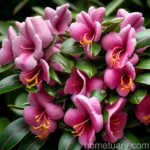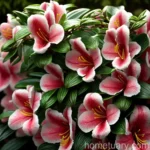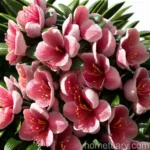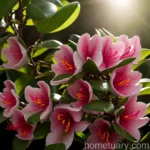Azalea (Rhododendron ‘Hilda Niblett’) – A Comprehensive Guide to Care

Azaleas are renowned for their spectacular flowers and have been a favorite among gardeners for centuries. The Rhododendron ‘Hilda Niblett’ is a particularly stunning variety, known for its vibrant blooms and hardy nature. In this comprehensive guide, we’ll delve into every aspect of caring for the azalea ‘Hilda Niblett’, from its cultural requirements to common diseases and pest control. Whether you’re a seasoned gardener or just starting out, this guide will equip you with the knowledge to cultivate thriving azaleas in your garden.
What is Azalea ‘Hilda Niblett’?
The Rhododendron ‘Hilda Niblett’ is a hybrid evergreen azalea that belongs to the Rhododendron genus. This variety is prized for its compact growth habit, stunning clusters of pink blooms, and its ability to thrive in various garden settings. It is a popular choice for borders, woodland gardens, and containers, adding a splash of color and elegance to any landscape.
Key Takeaways – Azalea ‘Hilda Niblett’
- Beautiful clusters of pink flowers
- Compact growth habit
- Well-suited for borders, woodland gardens, and containers
- Hardy and versatile
Culture
Cultivating azaleas, especially the ‘Hilda Niblett’ variety, requires a good understanding of the plant’s specific cultural needs. Let’s explore each aspect in detail.
Uses
The ‘Hilda Niblett’ azalea can be used in various ways to enhance the aesthetic appeal of your landscape. Here are some common uses:
– Borders: Planting ‘Hilda Niblett’ along garden borders can create striking visual appeal, especially when in bloom.
– Woodland Gardens: The compact nature of this variety makes it well-suited for woodland garden settings, where it can thrive under the filtered light of trees.
– Containers: ‘Hilda Niblett’ can be grown successfully in containers, adding a pop of color to patios, balconies, and porches.
Water
Proper watering is crucial for the health and vitality of the azalea ‘Hilda Niblett’. It is important to maintain consistent moisture levels, especially during dry periods and hot weather. However, overwatering should be avoided as it can lead to root rot. Here are some watering tips:
– Regular Watering: During the growing season, ensure the plant receives consistent moisture, especially during dry spells.
– Avoid Waterlogged Soil: Good drainage is essential; water should not accumulate around the roots.
Sunlight
Azaleas, including the ‘Hilda Niblett’ variety, thrive in dappled or filtered sunlight. Finding the right balance of light exposure is crucial for optimal growth and flowering. Here are some sunlight considerations:
– Filtered Light: Ideal placement is under the canopy of taller trees or in spots that receive partial sunlight throughout the day.
– Morning Sun: Some morning sun is beneficial, but protection from intense afternoon sunlight is essential to prevent heat stress.
Fertilizer
Proper fertilization is essential for promoting healthy growth and abundant blooms in the ‘Hilda Niblett’ azalea. Using a balanced, acid-loving plant fertilizer can provide the necessary nutrients. Here are some tips for fertilizing azaleas:
– Acidic Fertilizer: Choose a fertilizer specifically formulated for acid-loving plants, as azaleas thrive in acidic soil conditions.
– Timing: Fertilize in early spring before the new growth begins and then again after the flowering period.
Soil
The right soil conditions are critical for the ‘Hilda Niblett’ azalea to thrive. Well-draining, acidic soil with high organic matter content is ideal for these plants. Consider the following soil requirements:
– Acidic pH: Azaleas prefer soil with a pH range between 4.5 and 6.0.
– Organic Matter: Amending the soil with organic matter such as peat moss or compost can improve both the structure and fertility of the soil.
Pruning
Pruning is an important aspect of azalea care, including the ‘Hilda Niblett’ variety. Proper pruning helps maintain the plant’s shape, encourages bushier growth, and enhances flowering. Here are a few pruning tips:
– After Flowering: Prune the azalea immediately after flowering to shape the plant and remove any dead or overgrown branches.
– Light Pruning: Regular light pruning throughout the growing season can help maintain the desired shape and promote new growth.
Propagation
The propagation of azaleas, including the ‘Hilda Niblett’ variety, can be achieved through various methods such as cuttings and layering. Here’s a brief overview of propagation techniques:
– Stem Cuttings: Take semi-hardwood cuttings in late spring or early summer and root them in a well-draining propagation medium.
– Layering: Encourage the lower branches of the plant to root by burying a portion of the stem in the soil while still attached to the parent plant.
Container Popularity
Azaleas, particularly the ‘Hilda Niblett’ variety, are popular choices for container gardening due to their compact size and colorful blooms. Here are some key considerations for growing azaleas in containers:
Container
- Selecting the Right Container: Choose a well-draining container that is large enough to accommodate the mature size of the plant and has adequate drainage holes at the bottom.
- Potting Mix: Use a well-draining, acidic potting mix formulated for acid-loving plants, or create a custom mix using peat moss and perlite.
Common Diseases
Azaleas, including the ‘Hilda Niblett’ variety, are susceptible to certain diseases, and early diagnosis is crucial for effective management. Here are some common diseases and their diagnosis:
Disease Diagnosis
- Powdery Mildew: A white, powdery fungal growth on the leaves.
- Leaf Spot: Dark, discolored spots or lesions on the leaves.
- Root Rot: Wilted, yellowing foliage and mushy roots are signs of this fungal disease.
Common Pests
Several pests can affect azaleas, and early detection and intervention are essential for preventing significant damage. Here are some common pests that can infest azaleas:
– Azalea Lace Bug: These insects cause stippling and discoloration on the leaves due to their feeding habits.
– Spider Mites: Tiny pests that can cause webbing and stippling damage on the foliage.
Botanist’s Tips
Here are some expert tips for successfully growing and caring for the ‘Hilda Niblett’ azalea:
- Mulching: Apply a layer of organic mulch around the base of the plant to retain moisture and suppress weed growth.
- Winter Protection: In colder climates, provide winter protection by covering the plant with burlap or placing a layer of mulch around the base to insulate the roots.
Fun Facts
Here are some interesting and lesser-known facts about the ‘Hilda Niblett’ azalea:
– The cultivar ‘Hilda Niblett’ was named after the renowned English gardener Hilda Niblett in recognition of her contributions to horticulture.
– Azaleas are native to several continents, including Asia, Europe, and North America, and are part of the Rhododendron genus.
Links to External Resources
For additional information on azalea care, varieties, and landscaping ideas, consider exploring the following resources:
– American Rhododendron Society
– The Azalea Society of America
– University Cooperative Extension Services – Local extension services can provide region-specific guidance on azalea care and maintenance.
With the comprehensive insights provided in this guide, you are well-equipped to cultivate and care for the stunning ‘Hilda Niblett’ azalea in your garden. Whether you are drawn to its vibrant blooms, compact growth habit, or its versatility in various garden settings, the ‘Hilda Niblett’ is indeed a delightful addition to any landscape.
Remember, the key to successful azalea care lies in meeting its specific cultural requirements, maintaining vigilance against diseases and pests, and enjoying the beauty it brings to your outdoor spaces.
Happy gardening!















